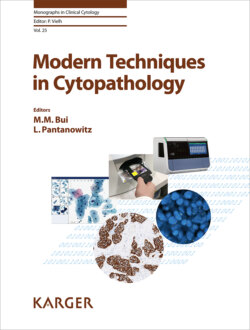Читать книгу Modern Techniques in Cytopathology - Группа авторов - Страница 22
На сайте Литреса книга снята с продажи.
Cell Blocks: Overview
ОглавлениеCell blocks are a point of convergence between cytology and histology. As a cytology specimen, a cell block is composed of single cells and minute tissue fragments, and similar to histology specimens, it is embedded in a paraffin block and can yield multiple slides for HE staining and ancillary studies. The value of a well-prepared cell block is to provide diagnostic information and adequate material for ancillary testing.
Cytology specimens from which cell blocks can be made include FNA and exfoliative samples; the latter includes gynecological (e.g., Pap tests) and non-gynecological specimens (e.g., effusions, bronchoalveolar lavage, cyst drainages, and urine). The vast majority of cell blocks are prepared from FNA and non-gynecological exfoliative specimens. In fact, FNAs are often routinely supplemented with cell blocks, especially in cases where malignancy is suspected clinically. Some institutions make cell blocks whenever a visible sediment is present, whilst others are more selective. For non-gynecological exfoliative samples, effusions represent the most common subtype to have accompanying cell blocks. Less frequently, they may be prepared from urine samples and Pap test specimens, especially to better characterize glandular lesions in Pap tests [1].
Cell blocks are prepared by concentrating the individual cells and small tissue fragments of a cytology specimen into a pellet. In this way, the sample is similar to a larger and more cohesive histology specimen. Once a pellet is formed, most cell block procedures will proceed by placing the sample in a tissue cassette and processing this sample as a histology specimen. Key steps for cell block procedures include rinsing aspirated material from an FNA into a medium, cytoconcentration, and pellet formation. These steps also represent points of divergence in procedures between laboratories.
